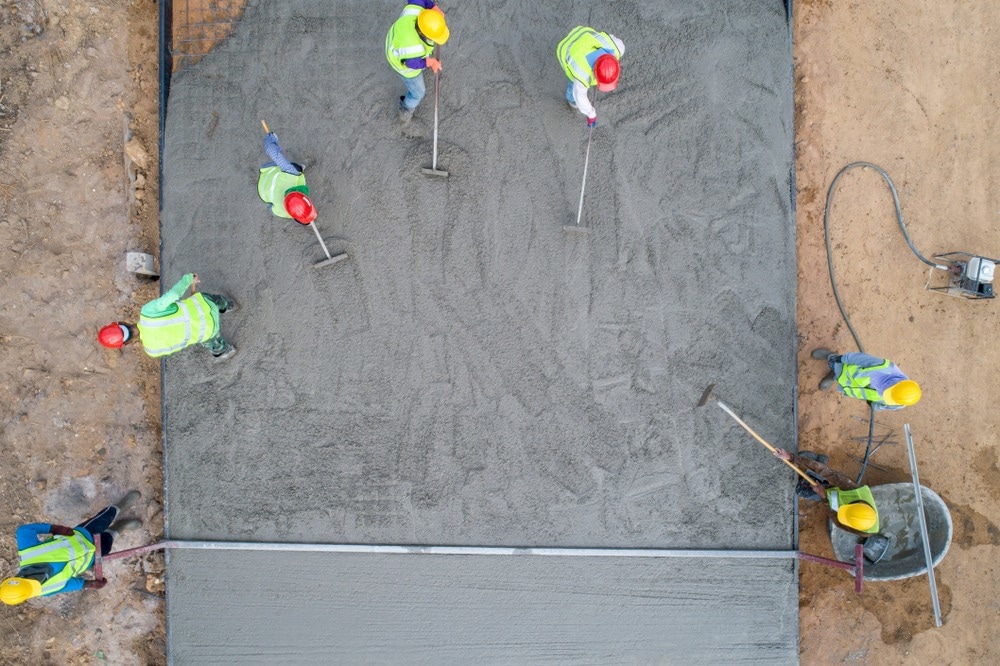Concrete is the most commonly used construction material in the world, but its use comes with some key environmental, technical, and durability issues. Now, Mimicrete, a start-up based in the UK, has unveiled proprietary self-healing concrete with the aim of improving the sustainability of construction.

Image Credit: Bannafarsai_Stock/Shutterstock.com
Self-healing Concrete: A Futureproof Construction Solution?
Self-healing concrete is an innovative solution to the problems of conventional concrete production. Chief amongst these issues is the environmental impact of concrete production, which is estimated to contribute around 8% of total global CO2 emissions, and the durability of structures.
Traditional concrete requires constant maintenance and repair over its lifespan (which is typically only a few decades at most), which further increases the costs of buildings and infrastructure. The ability to self-heal cracks in concrete is therefore highly attractive for structural engineers and urban planners.
Maintaining and repairing concrete is labor-intensive and costly, with further carbon emissions produced over the lifetime of a structure in addition to those produced during construction. By imbuing new structures and retrofitted elements with this ability, significant energy, labor, and costs can be saved.
The cost of monitoring, maintaining, and repairing damaged concrete structures is staggering. In the UK alone, £51bn is spent annually by the construction industry and local authorities on this purpose.
Several products have been researched and developed over the last few decades to solve this problem. The main method employed in self-healing concrete is the use of biomimetic and organic technologies, which can repair any damage done from environmental factors.
Mimicrete’s Innovative Technological Solution
Mimicrete’s solution involves the use of an innovative biomimetic vascular network throughout the concrete. Contained within these networks is a healing agent, which acts to repair damage done during normal operation and from environmental events.
The new material’s network of tubes is analogous to the human vascular system: when a cut occurs, clotting agents travel to the site of the injury and cause the blood to coagulate, healing the injury. Cracks in the concrete also cause the tubes to crack, with the healing agent acting like an organic coagulating agent.
A central benefit of this proprietary product is the lack of manual investment required post-installation. Additionally, there is less need to monitor structures for potentially catastrophic failures as Mimicrete’s concrete is strengthened immediately upon installation.
The vascular network’s healing agent is contained in microcapsules, which are deployed within the concrete when damage is caused to the structure, filling in any cracks that emerge before potentially catastrophic failure occurs. In doing so, the durability of this new product is significantly enhanced.
Funding and Current Development Projects
Mimicrete’s vision is being supported by a £450k grant from Innovate UK, an initiative by the UK Government to foster innovative, disruptive technologies in multiple industrial fields. This funding will help this female-founded company further develop its vascular self-healing concrete approach.
Innovate UK’s support provides the company with a platform for the commercialization of the product. Additional funding has come from US-based Venture Investors, including Leonas Capital.
Currently, the product is at the prototype stage, with commercial partner JP Concrete, a provider of concrete to agricultural and construction markets, exploring its viability as a commercial product in a pilot project.
If the pilot project is successful, Mimicrete’s self-healing concrete could disrupt the global market for concrete, a $394 billion behemoth as of 2023.
The Future
The global construction industry is responsible for a stunning amount of carbon emissions per year, making it a key driver of anthropogenic climate change. Rising global temperatures and increasingly extreme weather events are an existential threat to human society, making solutions like Mimicrete’s crucial.
Concrete has been termed the most destructive material in the world by several researchers and commentators. Many observers have called for a total rethink on the use of concrete, requiring entire new supply chains, which would prove to be prohibitively time-consuming and costly at a time when action is needed.
Despite its well-publicized environmental and durability issues, concrete is still extremely useful due to its low-cost nature and superior physical, mechanical, and chemical properties. It is highly unlikely that concrete will be replaced by an alternative material any time soon for construction.
Moreover, as the world rapidly urbanizes, demand for concrete will only increase. Mimicrete’s self-healing concrete, if deployed at scale, could mitigate the environmental impact of concrete, reduce the amount needed in new buildings and infrastructure, and produce structures that last much longer than they do currently.
As Mimicrete’s CEO Arta Selmani has said, “With innovation like Mimicrete’s we can help decarbonize the construction industry by using less concrete, cutting ongoing maintenance expenditures, yearly carbon emissions, and reducing the overall environmental impact.”
More from AZoBuild: Sustainable Challenges in the Cement Industry
Further Reading and More Information
Mimicrete (homepage) Available at:
https://www.mimicrete.com/
Scialom, M (2022) Mimicrete sets up first commercial pilot for self-healing concrete [online] cambridgeindependent.co.uk. Available at:
https://www.cambridgeindependent.co.uk/business/mimicrete-sets-up-first-commercial-pilot-for-self-healing-co-9262828/
Geschwindt, S (2022) Cambridge startup Mimicrete gets cash injection for ‘self-healing concrete’ [online] buildindigital.com. Available at:
https://buildindigital.com/cambridge-startup-mimicrete-gets-cash-injection-for-self-healing-concrete/
Disclaimer: The views expressed here are those of the author expressed in their private capacity and do not necessarily represent the views of AZoM.com Limited T/A AZoNetwork the owner and operator of this website. This disclaimer forms part of the Terms and conditions of use of this website.